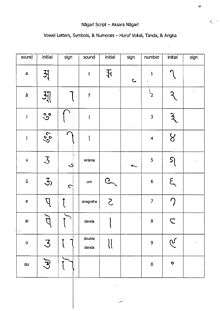Nāgarī script
| Nāgarī | |
|---|---|
|
Copper plates in Nāgarī script, 1035 CE | |
| Type | |
| Languages |
Sanskrit Old Javanese Old Sundanese |
Time period | c. 750–Present |
Parent systems | |
Child systems | Nandinagari |
Sister systems |
Śāradā Siddhaṃ |
|
[a] The Semitic origin of the Brahmic scripts is not universally agreed upon. | |
The Nāgarī script is the ancestor of Devanagari, Nandinagari and other variants, and was first used to write Prakrit and Sanskrit. The term is sometimes used as a synonym for Devanagari script.[1][2] It came in vogue during the first millennium CE.[3]
The Nāgarī script has roots in the ancient Brahmi script family.[4] Some of the earliest epigraph evidence attesting to the developing Sanskrit Nāgarī script in ancient India is from the 1st to 4th century CE inscriptions discovered in Gujarat.[5] The Nāgarī script was in regular use by 7th century CE, and had fully evolved into Devanagari and Nandinagari[6] scripts by about the end of first millennium of the common era.[1][7]
Origins
The Nāgarī script appeared in ancient India as an central- eastern variant of the Gupta script (whereas Śāradā was the western variety and Siddham was the far eastern variety). In turn it branched off into several scripts, such as Devanagari and Nandinagari, and also influenced the development of the Śāradā-derived Gurmukhī script.
Usage outside India
The Tibetan king Srong-tsan-gambo of 7th century ordered that all foreign books be transcribed into Tibetan language, sent his ambassador Tonmi Sambota to India to acquire alphabet and writing methods, who returned with Sanskrit Nāgarī script from Kashmir corresponding to 24 Tibetan sounds and innovating new symbols for 6 local sounds.[8]
The museum in Mrauk-u (Mrohaung) in the Rakhine state of Myanmar (Burma) held in 1972 two examples of Nāgarī script. Archaeologist Aung Thaw[9] writes: "... epigraphs in mixed Sanskrit and Pali in North-eastern Nāgarī script of the 6th century dedicated by (Kings) Niti Candra and Vira Candra", of a dynasty hailing from Vesáli in India.


See also
- Brahmi script
- Devanagari
- Lipi – writing scripts in Buddhist, Hindu and Jaina texts
Citations
- 1 2 Kathleen Kuiper (2010), The Culture of India, New York: The Rosen Publishing Group, ISBN 978-1615301492, page 83
- ↑ George Cardona and Danesh Jain (2003), The Indo-Aryan Languages, Routledge, ISBN 978-0415772945, pages 68-69
- ↑ Devanagari through the ages,Issue 8 of Publication, India Central Hindi Directorate Issue 8 of Publication (Instituut voor Toegepaste Sociologie te Nijmegen). Published 1967 Original from the University of California. 1967.
- ↑ George Cardona and Danesh Jain (2003), The Indo-Aryan Languages, Routledge, ISBN 978-0415772945, pages 68-69
- ↑ Gazetteer of the Bombay Presidency, p. 30, at Google Books, Rudradaman’s inscription from 1st through 4th century CE found in Gujarat, India, Stanford University Archives, pages 30-45
- ↑ Nandanagiri Unicode Standards
- ↑ Richard Salomon (2014), Indian Epigraphy, Oxford University Press, ISBN 978-0195356663, pages 33-47
- ↑ William Woodville Rockhill, Annual Report of the Board of Regents of the Smithsonian Institution, p. 671, at Google Books, United States National Museum, page 671
- ↑ Historical Sites in Burma, 1972